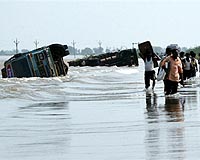| . |  |
. |
Manila (AFP) Oct 8, 2009 Lying on a bamboo bed with the sickening smell of rotten garbage wafting through a tiny window at a Philippine evacuation camp, a weary Marites Gural gave birth to her sixth child on Thursday. After nearly six hours of labour, Gural delivered a 2.9-kilogramme (6.5-pound) boy her husband named King Louie, to give the boy from a sprawling Manila slum an air of royalty. "Thank you, thank you for helping me," Gural whispered to Jean Demegillo, a midwife who has volunteered to help pregnant women since the September 26 floods devastated parts of the Philippine capital, killing 298 people. "My baby and I wouldn't have made it without your help." Gural, 34, gave birth to King Louie in a concrete building that had been converted into a makeshift emergency ward beside a covered basketball court housing nearly 800 homeless flood victims. She was among the more than 14,000 pregnant women scattered in hundreds of cramped evacuation camps in Manila and surrounding districts, according to estimates from the United Nations Population Fund (UNFPA). With more than 300,000 people in the evacuation centres desperately needing basic supplies such as food and water, pregnant women have been largely overlooked, said the UNFPA's Philippines representative, Suneeta Mukherjee. Without adequate health care, they and their babies could die, Mukherjee warned. "The problem with pregnant women is that they have to deliver. They can't stop it when their time comes," Mukherjee told AFP. "But... (if) they don't have facilities, the whole thing can get septic. "There are a lot of pregnant and postpartum women in the evacuation centres who do not have access to prenatal, natal and post-natal care, and we cannot allow the situation to remain this way." Of the 18 government-run pediatric and health care centres in the suburban area of Cainta where Gural gave birth only three are still operational, with all the others still under water, Mukherjee said. Cainta's municipal health chief, Olga Abellanosa, said there were 2,158 pregnant women monitored in evacuation camps in the area. "They can't go back to their ruined communities, and we don't have the capacity to take them all in," Abellanosa said. "Many of them have been neglected, with some told to remain in their partly submerged homes while the husbands sought help." Gural's contractions began at dawn and steadily intensified over several hours. With no doctors around and no transport to rush her to hospital, her husband called in the neighbourhood's traditional healer, an elderly woman with a weather-beaten face whose best advice was to wait it out. Without professional help in the form of a midwife, Gural would have died from internal bleeding, according to Demegillo. King Louis was the second baby born in less than 12 hours at a Cainta evacuation site. Earlier in the week, a 30-year-old woman gave birth to her second child by herself, with a pair of unsterilized scissors used to cut the umbilical cord, according to the municipal health office. As Gural was giving birth, Mukherjee's team was giving about 500 pregnant evacuees pre-natal check ups and hygiene kits across town at the municipal centre. "I had intended to go there, but my boy decided to be born today," Gural said. Share This Article With Planet Earth
Related Links Bringing Order To A World Of Disasters When the Earth Quakes A world of storm and tempest
 India floods death toll crosses 300: officials
India floods death toll crosses 300: officialsBurdipadu, India (AFP) Oct 7, 2009 The death toll from the worst floods to hit southern India in decades passed 300, officials said Wednesday, as relief efforts struggled to help survivors. At least 1.5 million people have been displaced in the states of Karnataka, Maharashtra and Andhra Pradesh after days of torrential rain. More than 200 people have been killed in Karnataka alone, said H.V. Parashwanath, secretary of ... read more |
|
| The content herein, unless otherwise known to be public domain, are Copyright 1995-2009 - SpaceDaily. AFP and UPI Wire Stories are copyright Agence France-Presse and United Press International. ESA Portal Reports are copyright European Space Agency. All NASA sourced material is public domain. Additional copyrights may apply in whole or part to other bona fide parties. Advertising does not imply endorsement,agreement or approval of any opinions, statements or information provided by SpaceDaily on any Web page published or hosted by SpaceDaily. Privacy Statement |